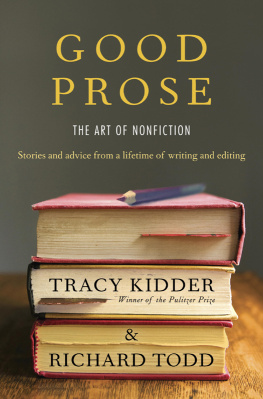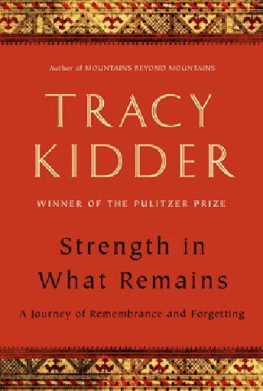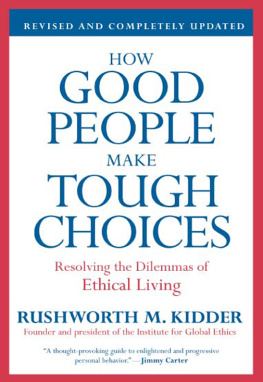ACKNOWLEDGMENTS

We wish to thank Kate Medina, Betsy Lerner, Georges Borchardt, and Chris Jerome for their generosity, enthusiasm, and guidance. We are grateful to Anna Pitoniak, Evan Camfield, and London King of Random House, and to the writers Stuart Dybek, Tom French, Darcy Frey, Diane Hume George, Pamela Haag, Michael Janeway, Suzannah Lessard, Michael Ponsor, and Barbara Wallraff. Above all, we owe thanks to our families for their patience and wisdom.
A LSO BY T RACY K IDDER
The Soul of a New Machine
House
Among Schoolchildren
Old Friends
Home Town
Mountains Beyond Mountains
My Detachment
Strength in What Remains
A LSO BY R ICHARD T ODD
The Thing Itself
ABOUT THE AUTHORS

T RACY K IDDER graduated from Harvard and studied at the University of Iowa. He has won the Pulitzer Prize, the National Book Award, the Robert F. Kennedy Award, and many other literary prizes. The author of Strength in What Remains, My Detachment, Mountains Beyond Mountains, Home Town, Old Friends, Among Schoolchildren, House, and The Soul of a New Machine, Kidder lives in Massachusetts and Maine.
R ICHARD T ODD has been a magazine and book editor for more than forty years. He was executive editor of The Atlantic Monthly and published books under his own imprint at Houghton Mifflin. He has contributed reportage and cultural criticism to a number of magazines, and is the author of The Thing Itself. He has taught at Amherst and Smith colleges and the University of Massachusetts; currently he is on the faculty of the Goucher College MFA program.
WRITING GUIDES AND REFERENCES: A SELECTIVE BIBLIOGRAPHY

The Artful Edit, by Susan Bell (Norton)
The Art of Time in Memoir, by Sven Birkerts (Graywolf Press)
The Writing Life, by Annie Dillard (Harper & Row)
Writing with Power, by Peter Elbow (Oxford University Press)
Writing Creative Nonfiction, edited by Carolyn Forch and Philip Gerard (Story Press)
Tough, Sweet and Stuffy, by Walker Gibson (Indiana University Press)
The Situation and the Story, by Vivian Gornick (Farrar, Straus and Giroux)
Intimate Journalism: The Art and Craft of Reporting Everyday Life, by Walt Harrington (Sage)
On Writing, by Stephen King (Scribner)
Telling True Stories, edited by Mark Kramer and Wendy Call (Plume)
Bird by Bird: Some Instructions on Writing and Life, by Anne Lamott (Pantheon)
The Forest for the Trees, by Betsy Lerner (Riverhead)
Unless It Moves the Human Heart, by Roger Rosenblatt (Ecco)
The Elements of Style, by William Strunk, Jr., and E. B. White (Macmillan)
Clear and Simple as the Truth, by Francis-Noel Thomas and Mark Turner (Princeton University Press)
Word Court, by Barbara Wallraff (Harcourt)
Style, by Joseph M. Williams and Gregory G. Colomb (Longman)
On Writing Well, by William Zinsser (Harper & Row)
The Chicago Manual of Style, by University of Chicago Press staff (University of Chicago Press)
Modern English Usage, by H. W. Fowler, revised edition by Sir Ernest Gowers (Oxford University Press)
Modern American Usage, by Wilson Follett (Hill and Wang)
Words into Type, by Marjorie E. Skillin and Robert M. Gay (Prentice-Hall)
BEGINNINGS

The first time I worked with Todd was over the phone. We talked about the article I was trying to write. The conversation went like this:
What was wrong with the article? I asked.
Well, first of all, he said, and he paused, as if perhaps he was sorry to have to say this. Well, first of all, the first sentence.
I had wanted a spectacular opening. My first sentence read: In the spring of 1971, someone went mad for blood in the Sacramento Valley. A fellow student at the Iowa Writers Workshop had praised that sentence. Todd didnt like it?
No, he said, it was melodramatic.
Reminded of this conversation decades later, Todd said with a touch of irony, which I hadnt heard in his voice back then: Well, I guess I stand by that judgment.
TK
To write is to talk to strangers. You want them to trust you. You might well begin by trusting themby imagining for the reader an intelligence at least equal to the intelligence you imagine for yourself. No doubt you know some things that the reader does not know (why else presume to write?), but it helps to grant that the reader has knowledge unavailable to you. This isnt generosity; it is realism. Good writing creates a dialogue between writer and reader, with the imagined reader at moments questioning, criticizing, and sometimes, you hope, assenting. What you know isnt something you can pull from a shelf and deliver. What you know in prose is often what you discover in the course of writing it, as in the best of conversations with a friendas if you and the reader do the discovering together.
Writers are told that they must grab or hook or capture the reader. But think about these metaphors. Their theme is violence and compulsion. They suggest the relationship you might want to have with a criminal, not a reader. Montaigne writes: I do not want a man to use his strength to get my attention.
Beginnings are an exercise in limits. You cant make the reader love you in the first sentence or paragraph, but you can lose the reader right away. You dont expect the doctor to cure you at once, but the doctor can surely alienate you at once, with brusqueness or bravado or indifference or confusion. There is a lot to be said for the quiet beginning.
The most memorable first line in American literature is Call me Ishmael. Three words, four beats. The sentence is so well known that sometimes, cited out of context, it is understood as a magisterial command, a booming voice from the pulpit. It is more properly heard as an invitation, almost casual, and, given the complexity that follows, it is marvelously simple. If you try it aloud, you will probably find yourself saying it rather softly, conversationally.
Many memorable essays, memoirs, and narratives reach dramatic heights from such calm beginnings. In Cold Blood is remembered for its transfixing and frightening account of two murderers and their victims, and it might have started in any number of dramatic ways. In fact, it starts with a measured descriptive passage:
The village of Holcomb stands on the high wheat plains of western Kansas, a lonesome area that other Kansans call out there. Some seventy miles east of the Colorado border, the countryside, with its hard blue skies and desert-clear air, has an atmosphere that is rather more Far West than Middle West.
Although a bias toward the quiet beginning is only a bias, a predisposition, it can serve as a useful check on overreaching. Some famous beginnings, of course, have been written as grand propositions (All happy families are alike ) or sweeping overviews (It was the best of times ). These rhetorical gestures display confidence in the extreme, and more than a century of readers have followed in thrall. Expansiveness is not denied to anyone, but it is always prudent to remember that one is not Tolstoy or Dickens and to remember that modesty can resonate, too. Call me Ishmael.










